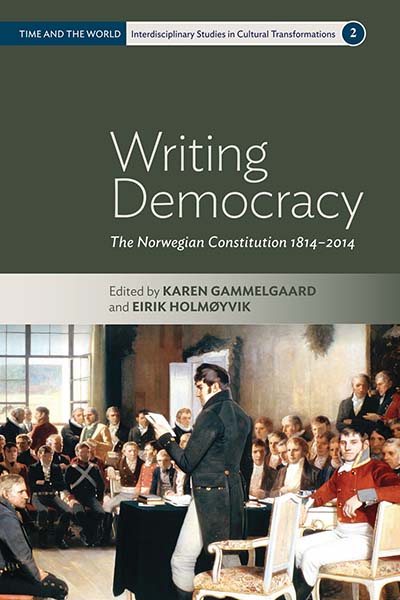When it was signed May 17, 1814, the Constitution of Norway was considered one of the most radical Constitutions of the day. To celebrate the 200th year since it was first enacted, editors Karen Gammelgaard and Eirik Holmøyvik and their contributors have written a collection of historical accounts about the document. Their book Writing Democracy: The Norwegian Constitution 1814-2014 was published this month. Following, the editors provide more information about the history of this guiding document as well as the history of the volume.
What drew you to the study of the Norwegian Constitution?
For researchers in Norway it has been impossible not to be drawn to the Norwegian Constitution these last few years due to the bicentenary in 2014.
In addition, there seems to have been an increasing interest lately in comparative studies on constitutions. Our contribution to this growing body of research is to study one constitution, but from different disciplinary points of view.
How significantly has this document changed since it was originally written more than 200 years ago?
In many ways, the Norwegian Constitution has been a living document during its entire life span. So, in 200 years, it has been formally amended more than 300 times. To put this number into perspective we can compare it to the 27 amendments to the slightly older U.S. Constitution of 1787. Yet formal amendments don’t tell the entire story. As with all texts, constitutions are being interpreted and re-interpreted all the time to keep up with changes in society and political needs. This is also true for the Norwegian constitution. In many ways, the Norwegian Constitution is a very different text today compared to its adoption in 1814. Yet its structure and concepts as well as many of its articles are the same. The different historical layers in the constitutional text evidence Norway’s political and constitutional development during 200 years.
Did any perceptions on the subject change from the time you started your research/compiled the contributions to the time you completed the volume?
Absolutely! Our authors uncovered more perspectives and nuances to not only the Norwegian Constitution, but also to constitutions as a legal and historical genre, than we first imagined. The Norwegian 1814 constitution is the research object in this book, but the book is really about the nature of constitutional texts in general.
What aspect of compiling an edited collection did you find most challenging? Most rewarding?
In a multidisciplinary book like this, challenges and rewards are closely intertwined. The obvious challenge is to make linguists, historians, sociologists, and lawyers, each with their own methods and perspectives, work together and share the same vision. That being said, our group of authors all co-operated very well. The reward is to see how these very different methods and perspectives applied to the same research object provide complimentary and unexpected insights.
To what extent do you think the book will contribute to debates among current and future academics within the field?
We hope this book may contribute to the understanding of constitutions as a concept and as a text, including all the aspects of constructing, writing, reading, disseminating, and interpreting that those two phenomena entail. Another ambition with the book is to contribute to the understanding of how constitutional texts evolve over time.
Do you think there are aspects of this work that will be controversial to other scholars working in the field?
The multidisciplinary approach might be controversial to purists of any single field. More importantly, we believe the studies in this book will provide new insights to the field of constitutional studies simply because there is very little English language literature on the Norwegian constitution. We believe this constitution with its unique and long history is very valuable to the understanding of constitutions in general.
Who is one iconic figure featured in one way or another in your field of research, living or dead, for whom you have particular admiration and why?
German historian Reinhart Koselleck is an inspiration to many of the book’s authors both because of his multidisciplinary work and because he showed how linguistic units intertwine with social and political historical contexts. Importantly, all our authors also came to admire the 1814 framers of the Norwegian constitution for their erudition, farsightedness, and writing style. On top of its many other qualities, the Norwegian constitution is a beautifully written text.
What is one particular area of interest or question, that hasn’t necessarily been the focus of much attention, which you feel is especially pertinent to your field today and in the future?
More attention should be directed to framers’ meticulous work in the very process of writing constitutions. This work often lacks the outward drama of real battlefields. Instead of weapons, framers use pen and paper. Yet their struggle to put words and sentences into text may have very important consequences for the society they serve.
________________________________________
Series: Volume 2, Time and the World: Interdisciplinary Studies in Cultural Transformations
Karen Gammelgaard is a Professor at the University of Oslo, Norway. Her publications focus on the interface between text and context and include Transforming National Holidays: Identity Discourse in the West and South Slavic Countries, 1985–2010 (co-editor, 2013) and Tekst og historie: Å lese tekster historisk (co-author, 2008).
Eirik Holmøyvik is a Professor at the University of Bergen, Norway. He has published numerous works on the Norwegian Constitution, including Maktfordeling og 1814 (2012) and Tolkingar av Grunnlova (2013). In 2012 he was a member of the committee appointed by the Norwegian Parliament to modernize the Constitution’s language.

